:::::::::::::::::::::::::::::::::::::::::::::::::::::::::::::::::::::::::::::::::::::::::::::::::::::
Dragonfly (tonboo, tomboo - Tombo)
***** Location: Japan
***** Season: All Autumn, and see below
***** Category: Animal
*****************************
Explanation
The dragonflies are the real harbingers of autumn here in the air! They come in many forms and sizes, some almost like small helicopters. And our cats love to chase after them when they start hopping over water puddles.

Shared by Pat Geyer
Joys of Japan, February 2012
Japan was once called Akitsushima meaning
"The Island of the Dragon-fly".
So this animal is very dear to the Japanese heart!
They are also a symbol of good luck here, because they never go back.
Most dragonflies are of course seen during other seasons too, but they are at their best, so to say, in autumn, therefore this is their use as a code word for poetry (kigo) .
There are also different kinds of dragonflies, some are kigo for other seasons, see below.
:::::::::::::::::::::::::::::::::::::::::::::::::::::::::::::::::::::::::::::::::::::::::::::::::::::::

Dragonfly and larva
Mori Shunkei 森春渓 (active around 1800-20 in Osaka)
:::::::::::::::::::::::::::::::::::::::::::::::::::::::::::::::::::::::::::::::::::::::::::::::::::::::
Let us look at some kigo with these animals.
dragonfly, tonbo (tombo, tonboo) 蜻蛉
..... seirei せいれい
..... akitsu あきつ
..... chan ちゃん
..... shibuchan 渋ちゃん(しぶちゃん)
..... yanma 蜻蜓(やんま)
..... enba えんば, enma えんま, tonboo とんぼう
big dragonfly, devil's dragonfly, oni yanma 鬼やんま(おにやんま)
Anotogaster sieboldii
silver dragonfly, gin yanma 銀やんま(ぎんやんま)
dragonfly with a small body, koshiboso yanma 腰細やなま
black yanma, kuro yanma 黒やんま(くろやんま)
green dragonfly, ao yanma 青ヤンマ、青やんま
"chinz yanma", sarasa yanma 更紗やんま(さらさやんま)
kiyanma 胡黎(きやんま)
green dragonfly, ao tonbo, aotonbo 青蜻蛉(あおとんぼ)
butterfly dragonfly, choo tonbo 蝶蜻蛉
salt dragonfly, shio tonbo 塩蜻蛉(しおとんぼ)
"salt store dragonfly", shioya tonbo 塩屋蜻蛉(しおやとんぼ)
Orthetrum japonicum japonicum
. . . . .
"shiokara tonbo" 塩辛蜻蛉(しおからとんぼ)
Orthetrum albistylum speciosum
. shiokara . is made from seafood pickled in salt.
A very common dragonfly. The belly of the male is white or light blue. The abdomen of the female is brown, she is called
wheat straw dragonfly, mugiwara tonbo
麦藁蜻蛉(むぎわらとんぼ)
..... straw dragonfly, mugi tonbo 麦蜻蛉(むぎとんぼ)
. . . CLICK here for Photos !
. . . . .
. shoojoo tonbo 猩々蜻蛉(しょうじょうとんぼ)
Shojo Dragonfly, "Tipster Sprite dragonfly
Crocothemis servilia mariannae
shooroo tonbo 精霊蜻蛉(しょうろうとんぼ)
lit. "lantern for the dead"
. . . . . or
"Buddha dragonfly", hotoke tonbo 仏蜻蛉(ほとけとんぼ)
Pantala flavescens
wide belly dragonfly, harahiro tonbo,
腹広蜻蛉(はらひろとんぼ)harabiro tonbo
Lyriothemis pachygastra
"tiger spotted dragonfly", torafu tonbo 虎斑蜻蛉(とらふとんぼ)
Epitheca marginata Selys
dragonfly in high mountains, takane tonbo
高嶺蜻蛉(たかねとんぼ)
Somatochlora uchidai
koshiaki tonbo こしあき蜻蛉(こしあきとんぼ)
Pseudothemis zonata
old dragonfly, mukashi tonbo 昔蜻蛉(むかしとんぼ)
Epiophlebia superstes
fishing with dragonflies, tonbo tsuri
蜻蛉釣(とんぼつり)
. . . . .
red dragonfly, aka tonbo
赤蜻蛉 赤とんぼ . アカトンボ
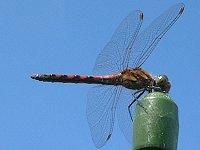
http://www.kagiken.co.jp/new/kojimachi/mushi.html
Sympetrum darwinianum
..... maybe the most loved one in Japan due to a children's song about it.
夕焼小焼の、赤とんぼ
負われて見たのは、いつの日か
You can listen to it here : Akatonbo Song
Other kigo names for this special red dragonfly are:
noshime のしめ
noshime tonbo のしめ蜻蛉
akienba 赤蜻蛉、赤卒
aki akane 秋茜 "red autumn"
akaenba 秋卒(あかえんば)
hatchoo tonbo 八丁蜻蛉(はっちょうとんぼ)
Nannophya pygmaea
Red Dragonfly deep in the mountains
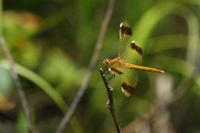
http://ww4.tiki.ne.jp/~quercus/satoyama/224-12.html
miyama akane 深山茜
Red Dragonfly with high eyebrows
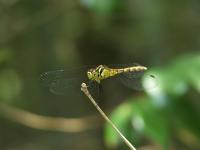
http://pd-hino.hp.infoseek.co.jp/Y2005/M507/z_mayutateakane5071.html
mayutate akane 眉立茜 マユタテアカネ
:::::::::::::::::::::::::::::::::::::::::::::::::::::::::::::::::::::::::::::::::::::::::::::::::::::
kigo for mid-summer
tonbo umaru 蜻蛉生る (とんぼうまる) dragonfly is born
..... yago やご, larvae of dragonfiels
yamame やまめ、taikomushi 太鼓虫(たいこむし)
tonbo no ko 蜻蛉の子(とんぼのこ)"dragonfly children"
. . . CLICK here for Photos !
Libellenlarve
:::::::::::::::::::::::::::::::::::::::::::::::::::::::::::::::::::::::::::::::::::::::::::::::::::::
:::::::::::::::::::::::::::::::::::::::::::::::::::::::::::::::::::::::::::::::::::::::::::::::::::::
Dragonfly
Anisoptera: Flying colors
Red, orange, yellow, green, blue, indigo, violet. We're not talking about the colors of the rainbow...we're talking dragonflies! When you consider that these common insects have been around for more than 200 million years, you could say that our planet has always been a very colorful place! But the dragonfly isn't born with his smashing fashion sense. He enters the world as a tiny egg--one of hundreds laid underwater by momma dragonfly. Next, he enters the larval stage, and is then known as a nymph. During this stage, the dragonfly nymph hangs out underwater, growing larger and larger, until he "sheds" his skin--and out pops a full-grown, full-blown dragonfly.
© Animal Encyclopedia
http://www.animaland.org/asp/encyclopedia/dragonfly.asp
xxxxxxxxxxxxxxxxxxxxxxxxxxxxx
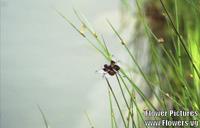
Link with photos of this animal.
http://www.flowers.vg/flowers/bug09.htm
xxxxxxxxxxxxxxxxxxxxxxxxxxxxx
An impressive page with all about the dragonfly, as symbol, in religion, in art and so on:
Cultural Odonatology References
http://uci.net/~pondhawk/odonata/cultural_odonatology.html
My safekeep copy is here:
All about the Dragonfly by Ron Lyons
*****************************
Worldwide use
France
Dragonflies (Odonata), or odonatoptères - more known as dragonflies - are one order of insects with elongated body with two pairs of membranous wings generally transparent and whose compound eyes and generally allow them to large effectively hunt their prey. They are aquatic in the larval state and terrestrial as adults. They are predators that may be encountered occasionally in any type of environment, but are more common in the vicinity of of areas freshwater to brackish , stagnant at current low, they need to reproduce.
In French language , the term dragonfly is generally used in a broad sense to refer to the Odonata, which include two sub-orders : damselflies ( Zygoptera ) and dragonflies strict sense ( Anisoptera ).
A third sub-order, Anisozygoptères ( Anisozygoptera ) has only Himalayan species and one Japanese. In 1996, Günter Bechly combined the two suborders Anisoptera and Anisozygoptera in Epiproctophora including their analogy in the larval stage (presence of épiproctes and not of caudal lamellae as in Zygoptera).

At edge of the pond
to keep me company
a young lady.
(Other word in french for dragonfly)
- Shared by Patrick Fetu -
Haiku Culture Magazine, 2013
:::::::::::::::::::::::::::::::::::::::::::::::::::::::::::::::::::::::::::::::::::::::::::::::::::::::::::::::::
Germany
Libelle, Libellen
*****************************
Things found on the way
The Dragon-fly
by Alfred Lord Tennyson apparently from ``The Two Voices''
Today I saw the dragon-fly
Come from the wells where he did lie.
An inner impulse rent the veil
Of his old husk: from head to tail
Came out clear plates of sapphire mail.
He dried his wings: like gauze they grew;
Thro' crofts and pastures wet with dew
A living flash of light he flew.
http://uci.net/~pondhawk/odonata/cultural_odonatology.html
:::::::::::::::::::::::::::::::::::::::::::::::::::::::::::::::::::::::::::::::::::::::::::::::::::::

. Tonbodama とんぼだま【蜻蛉玉】 Dragonfly Glass Beads
:::::::::::::::::::::::::::::::::::::::::::::::::::::::::::::::::::::::::::::::::::::::::::::::::::::
稲妻や浪もてゆ(結)へる秋津しま
inazuma ya nami moteyueru Akitsushima
lightning -
the Islands of Japan
are surrounded by waves
Tr. Gabi Greve
quote
lightning --
girdled by waves
islands of Japan
In this hokku, the light from the lightning (inazuma), a seasonal word for autumn associated in the ancient period with the rice harvest (ina), enables the viewer to see the waves surrounding all the islands of Akitsushima (an anceint name for Japan that originally meant the islands where rice grows richly). This is not the result of direct experience. It is a spectacular aerial view - a kind of paean to the fertility and beauty of the country - that would only be possible from far above the earth.
source : Haruo Shirane
A flash of lightning--
Wound around with waves
Akitsu Islands
Tr. Nelson/Saito
蜻蛉や村なつかしき壁の色
tonboo ya mura natsukashiki kabe no iro
this dragonfly -
the color of the walls
of my hometown village
The cut marker YA is at the end of line 1.
natsukashii a direct expression of his loving and longing emotions toward the village and the old walls.
. Yosa Buson 与謝蕪村 in Edo .
*****************************
HAIKU
蜻蛉釣り今日はどこまで行ったやら
tombo-tsuri kyoo wa doko made itta yara
catching dragonflies -
how far did we go
today ?
(Tr. Gabi Greve)
Chiyo-jo千代女 (Chiyo-Ni)
http://www.takase.com/Haiku/HaikuSource01.htm
:::::::::::::::::::::::::::::::::::::::::::::::::::::::::::::::::::::::::::::::::::::::::::::::::::::

Takarai Kikaku 宝井基角 wrote:
赤とんぼ羽をとったら唐がらし
akatonbo hane o tottara toogarashi
red dragonfly
when the wings are taken off
just a red pepper
When Basho saw Kikaku's haiku, he said:
"No, this is not a good haiku, because you kill the dragonfly.
If you want to make a good haiku,
you must give it life and say instead:
唐がらし羽をつけたら赤とんぼ
toogarashi hane o tsuketara akatonbo
red pepper -
put wings on it to get
a red dragonfly
.
Basho and Kikaku
Kikaku was just clever.
But to make a good haiku, you need more than cleverness:
You need compassion towards nature. So this was a great message to Basho's
students about the importance of nature and the importance of our attitude
towards nature.
- Good Advise for Writing Haiku -

source : oyamabatyan
:::::::::::::::::::::::::::::::::::::::::::::::::::::::::::::::::::::::::::::::::::::::::::::::::::::
垣竹と蜻蛉と映る障子かな
kaki-dake to tombo to utsuru shooji kana!
on my paper window
the shadow of a dragonfly
and the bamboo fence
許白
http://symnet.ishikawa-c.ac.jp/salon/haiku1.html
Bamboo as kigo, in art and in my garden
:::::::::::::::::::::::::::::::::::::::::::::::::::::::::::::::::::::::::::::::::::::::::::::::::::::
The Haiku Photo Gallery
http://home.alc.co.jp/db/owa/ph_detail?photo_sn_in=1454
Museki Abe
:::::::::::::::::::::::::::::::::::::::::::::::::::::::::::::::::::::::::::::::::::::::::::::::::::::
- - - - - Kobayashi Issa - - - - -
mikazuki o nirame tsumetaru tombo kana
scowling
at the sickle moon...
a dragonfly
Tr. David Lanoue
- - - - -
罪人を済度に入れるか赤とんぼ
zainin o saido ni ireru ka aka-tombo
red dragonflies,
are you here to lead criminals
to enlightenment?
Tr. Chris Drake
There may be other versions of this hokku, but I use the one in Issa's collected works 1.543. It's from a manuscript from 1823 and is an autumn hokku. Issa seems to be deeply moved by the many red dragonflies darting here and there, ignoring gravity in remarkable ways. They fly so freely they resemble bodhisattvas to Issa, and he uses Buddhist language (saido) to ask them if they are here in this world like bodhisattvas to guide even criminals to enlightenment and the other shore.
Surely he also means to Amida's Pure Land. Amida has promised to accept into the Pure Land even the most hardened and cruel criminals if they call out his name with an unwavering and utterly devout heart, and when Issa sees the dragonflies he also seems to feel a wave of utter devotion coming over him. He is no doubt acutely aware of his own imperfections, and he may feel no decisive difference between himself and the condemned criminals who often pass westward through his hometown on their way to work in the prison silver mines on Sado Island, out in the Japan Sea. To me this hokku may be asking the dragonflies if they would be willing to guide Issa, too.
Chris Drake
- - - - -
づぶ濡にぬれてまじまじ蜻蛉哉
zubunure ni nurete maji-maji tonbo kana
rain drips steadily
from unblinking
dragonfly eyes
Tr. Chris Drake
This hokku is from the 8th month (September) of 1817, when Issa was traveling around to see various haikai poets who lived near his hometown. Issa seems fascinated by the large, compound eyes (with 30,000 lenses) of a dragonfly staring hard at something in the rain. Bulbous eyes that resemble large goggles are wrapped around the dragonfly's head and neck, making possible 360-degree vision, and they have no eyelids, so raindrops strike the dragonfly's big eyes directly and then drip off them, allowing the dragonfly to stare intently despite the rain. Perhaps Issa wishes he could use his limited human eyes to stare equally hard and unflinchingly at everything in the world around him, even through rain and through various human restrictions that try to limit human vision.
Chris Drake
. Kobayashi Issa 小林一茶 in Edo .
:::::::::::::::::::::::::::::::::::::::::::::::::::::::::::::::::::::::::::::::::::::::::::::::::::::
yuku mizu ni onoga kage ou tombo kana
over the flowing water
chasing its shadow -
the dragonfly
Lady Chiyo-ni
:::::::::::::::::::::::::::::::::::::::::::::::::::::::::::::::::::::::::::::::::::::::::::::::::::::
蜻蜒や取りつきかねし草の上
tonboo ya tori tsuki kaneshi kusa no ue
this dragonfly -
it tries so hard to hold on
to a blade of grass
Tr. Gabi Greve
Written in Genroku 3 (1690).
. WKD - Matsuo Basho Archives 松尾芭蕉 .

:::::::::::::::::::::::::::::::::::::::::::::::::::::::::::::::::::::::::::::::::::::::::::::::::::::
red dragonfly: a gust bends the reeds
a red dragonfly hovers -- Daruma's robe
"chibi" (pen-name for Dennis M. Holmes)
Read more of Chibi's haiku on the dragonfly here:
http://darumasan.blogspot.com/2004/02/daruma-haiku-by-chibi.html
:::::::::::::::::::::::::::::::::::::::::::::::::::::::::::::::::::::::::::::::::::::::::::::::::::::
石垣に蜻蛉の蔭の踊りかな
ishigaki ni tonbo no kage no odori kana
old stone wall -
the dancing shadows of
dragonflies
alte Steinmauer -
die tanzenden Schatten
der Libellen
Click HERE to look at the wall.
Gabi Greve
:::::::::::::::::::::::::::::::::::::::::::::::::::::::::::::::::::::::::::::::::::::::::::::::::::::
Japanese link with many many many haiku about the dragonfly!
... ... ... とんぼの俳句
赤とんぼ空に流れる竜田川 (柳多留一)
亡き人のしるしの竹に蜻蛉かな 几薫
http://symnet.ishikawa-c.ac.jp/salon/haiku1.html
safekeep copy is here
http://blog.livedoor.jp/worldkigo/archives/30837644.html
:::::::::::::::::::::::::::::::::::::::::::::::::::::::::::::::::::::::::::::::::::::::::::::::::::::
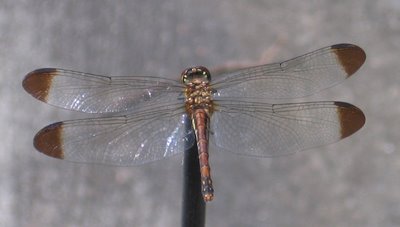
akatonbo sugu furusato ya nihonjin
赤蜻蛉 すぐ故郷や 日本人
red dragonfly -
the Japanese soon think of
their native place
Gabi Greve
red dragonfly in the heart
:::::::::::::::::::::::::::::::::::::::::::::::::::::::::::::::::::::::::::::::::::::::::::::::::::::
asamauathu
ore mazha ~
thumbikalellam olivil
[Malayalam]
untimely rains ~
dragonflies all
in hiding
Narayanan Raghunathan
http://www.wonderhaikuworlds.com/
:::::::::::::::::::::::::::::::::::::::::::::::::::::::::::::::::::::::::::::::::::::::::::::::::::::

Shared by Pat Geyer
Joys of Japan, February 2012
*****************************
Related words
***** damselfly, itotonbo 糸蜻蛉
tooshin tonbo 燈心蜻蛉(とうしんとんぼ)
toosumi tonbo とうすみ蜻蛉(とうすみとんぼ)
kigo for all summer

first damselfly -
prince frog rolls out
his carpet
первая стрекоза-красотка -
принц-лягушка раскатывает
свой длинный ковёр
Nancy Stewart Smith
http://www.worldhaikureview.org/4-1/whcrussian_files/slides/11.htm
xxxxxxxxxxxxxxxxxxxxxxxxxxxx
gentle breeze
a damselfly at rest
on a blade of grass
Bill Kenney
.................................................................................

pair of damselflies....
in an ephemeral life,
wish a great blessing
- Shared by Taisaku Nogi
Joys of Japan, March 2012
:::::::::::::::::::::::::::::::::::::::::::::::::::::::::::::::::::::::::::::::::::::::::::::::::::::

kawa tonbo 川蜻蛉 (かわとんぼ) "river dragonfly"
kanetsuke tonbo かねつけ蜻蛉(かねつけとんぼ)
ohaguro tonbo, o-haguro tonbo 鉄漿蜻蛉(おはぐろとんぼ)
Mnais nawai, Mnais pruinosa etc.
kigo for all summer
natsu akane 夏茜 (なつあかね) "summer akane"
kigo for all summer
. . . . .
sanaetonbo, sanae tonbo 早苗蜻蛉 (さなえとんぼ)
"dragonfly in the young rice plants"
kigo for mid-summer
. . . CLICK here for Photos !
:::::::::::::::::::::::::::::::::::::::::::::::::::::::::::::::::::::::::::::::::::::::::::::::::::::
***** Ephemera, kageroo, kagerō,
hiomushi 蜉蝣
early autumn. Some saijiki list it in spring.

Other Japanese names are:
かげろふ hiomushi 虫秀
dragonfly with a white belly, shirahara tonbo 白腹蜻蛉
spreckled dragonfly, madara tonbo 斑蜻蛉
shoosetsu tonbo 正雪蜻蛉 Shosetsu dragonfly
named after
. Yui Shōsetsu 由井正雪 Yui Shosetsu (1605 - 1651) .
Ephemera with a spot, mon kageroo 紋蜉蝣
This is a fly that lives only a few hours after it appears from its three years under water as a larvae. In German it is called: One-Day fly, Eintagsfliege. In English, it is also called May fly, although in Japan it is seen only from July to September.
Since it has such a short life, it is a symbol of the tragic life on earth. The flies come out in great crowds on Autumn evenings and dance like crazy, like snow.
The larvae of the the ant lion (arijigoku 蟻地獄) are called "usuba kageroo" usubakagerō 薄翅蜉蝣.
:::::::::::::::::::::::::::::::::::::::::::::::::::::::::::::
Kagero Nikki the Gossamer Years, 974
The Kagero Diary (Kagero nikki) Kageroo Nikki -
:::::::::::::::::::::::::::::::::::::::::::::::::::::::::::::
かげろうに妻奪われて急ぐなり
前田吐実男
十九歳蜉蝣の胴紙に貼る
四ッ谷龍
幽すいにたらふくなつてかげろへる
松澤昭
現代俳句データベース
xxxxxxxxxxxxxxxxxxxxxxxxxxxxxx
beim Schreiben des Gedichts:
eine Eintagsfliege läuft
über meine Hand
writing this poem:
a may fly crawls
over my hand
(Tr. Gabi Greve)
ziemlichkraus
http://www.ziemlichkraus.de/haiku/haiku.htm
.............................................................................
kigo for early summer
hoonenmushi 豊年虫 (ほうねんむし)
"kagero for a good harvest"
mon kageroo 紋蜉蝣(もんかげろう)
Ephemera japonica
. . . . .
kigo for late summer
kusa kageroo 草蜉蝣 (くさかげろう) lacewing fly
fam. Chrysopidae
:::::::::::::::::::::::::::::::::::::::::::::::::::::::::::::::::::::::::::::::::::::::::::::::::::::
Chinz さらさ, sarasa and kigo
[ . BACK to WORLDKIGO TOP . ]
[ . BACK to DARUMA MUSEUM TOP . ]
:::::::::::::::::::::::::::::::::::::::::::::::::::::::::::::::::::::::::::::::::::::::::::::::::::::







19 comments:
Dear Gabi san, what a nice dragonfly collection you've presented here! If I dare to add to your haiku/higa collection this haiga of mine, with the famous haiku of Chisoku, in three languages:
http://www.lishanu.com/01/haiga/haiga_origa2.htm
Thank you for all the interesting information, and for one more look at the Japanese culture! :-)
Origa
赤とんぼ と聞いただけで
もう秋だと感じます。
秋の季語の代表でしょう。
立派な特集ですね。
sakuo
clouds shift in
light ~ two dragonflies in
ambient acrobatics ~
... ... ...
raatri mazha
raavile soorya prapanchathil
nooru thumbikal ~ [ Malayalam ]
night rain
at dawn in sun worlds
a hundred dragonflies ~
Narayanan Raghunathan
::::::::::::::::::::::::::::::::::::::::::::::::::::::::::::::::::::::
asleep on the lotus
a dragonfly dreams floral
armies of dragons
Narayanan Raghunathan
::::::::::::::::::::::::::::::::::::::::::::::::::::::::::::::::::::::
damselfly
taking her gorgeous blue eyes
into the swamp's darkness
Tomislav Maretic, June 2006
:::::::::::::::::::::::::::::::::::::::::::::::::::::::::::::::::::::::::::::::::::::::::::::::::::::
dragonfly -
patterns of life
patterns of death
Look at them here.
Gabi Greve, Happy Haiku Gallery
:::::::::::::::::::::::::::::::::::::::::::::::::::::::::::::::::::::::::::::::::::::::::::::::::::::
dragonfly
gone
back again
chopper's growl
dragonfly doing loops
over the roses
Bill Kenney, June 2006
::::::::::::::::::::::::::::::::::::::::::::::::::::::::::::::::::::::
:::::::::::::::::::::::::::::::::::
dragonfly resting -
another moment
to share with you
Look at it HERE !
you, by the way, is for my husband.
Gabi Greve, September 2006
::::::::::::::::::::::::::::::::::::::::::::::::::::::::::::::::::::::
a brown dragonfly
on the brown wire --
only its head moves
Johannes Manjrekar, India
http://haiku.cc.ehime-u.ac.jp/nobo/20061128/18651.html
In ancient times, or so the myth goes, dragons could be summoned up through the embers of fire. A wizard cast spells and the tiny motes from a bonfire would take flight, rising higher and higher before transforming into a dragon and doing the wizard's bidding.
embers light
the night sky ~
dragonflies
--Trish
http://groups.yahoo.com/group/simply_haiku/message/20245
Written on 08 July 2007 --
sunset ...
a damselfly blocks
the frog's view
Ella Wagemakers
just a quick natural history note. Dragonflies are actually quite substantially older than the dinosaurs. The oldest dragonfly fossils go back to about 325 mya whereas dinosaurs go back only to about 230 mya. So dragonflies established their holding patterns for nearly 100,000,000 years before the first dinosaurs appeared. They extended their wings during the 160,000,000 years during which the dinosaurs reigned.
And they’ve been changing their grips for the 65,000,000 years since the Cretaceous-Tertiary Event, which they obviously survived, including inching out of husks in the 160,000-year blink-of-the-eye that modern humans have existed. Our brains aren’t really adapted to conceive of the ancientness of dragonflies.
Allan Burns
THF BLOG
http://thehaikufoundation.org/2009/08/05/3rd-sailing/comment-page-2/#comment-691
flapping sunlight
a dragonfly ~ another
watches the sky
蜻蜒や取りつきかねし草の上
tonbō ya / tori tsuki kaneshi / kusa no ue
Matsuo Basho
Ephemera (singular: ephemeron)
is any transitory written or printed matter not meant to be retained or preserved.
MORE
.
dragonfly -
what do you want to
teach me today ?
.
Look at my photos !
Kobayashi Issa
目のさやをずつとはづしてとんぼ哉
me no saya o zutto hazushite tombo kana
alert eyes
always open --
dragonfly
This hokku is from the intercalary eighth month (September) of 1824, when Issa was recuperating at the houses of various students from a mild stroke that left him temporarily unable to speak. The stroke was probably due to the severe stress Issa experienced after being divorced by his second wife shortly after they had married. While he was recovering, Issa had to communicate visually with sign language and gestures, and perhaps he empathizes with the dragonfly in this hokku, who looks hard and long and thoroughly observes everything, taking in all the details around him. Issa almost surely knows dragonflies have very large, goggle-like exoskeletal eyes that have no eyelids, but he uses a metaphorical phrase that literally means the dragonfly "takes off/removes its eyelids" for an extended period of time in order to examine everything carefully. Fascinated by the fierce, unwavering intensity of the dragonfly's gaze, Issa has been observing the dragonfly carefully for a while (zutto) himself, and he seems to be wondering whether his own bug-eyed gaze at the dragonfly has impressed the insect as much as its gaze has impressed him: the verb comes first in the hokku, so the subject isn't clear until the last line.
Chris Drake
.
Kobayashi Issa
とんぼうの赤きは人に追れけり
tomboo no akaki wa hito ni oware keri
the dragonfly's redness--
chased away
by people
Is Issa implying that people, attracted by the redness of the dragonfly, try to go near it or perhaps attempt to catch it? Or is his meaning more fanciful: that people have chased away a dragonfly's bright color?
David Lanoue
.
地獄谷あるとき群るる赤蜻蛉
jigokudani aru toki mururu akatonbo
hell valley -
sometimes red dragonflies
come in great numbers
岡田日郎 Okada Nichio
地獄谷あるとき群るる赤蜻蛉
jigokudani aru toki mururu akatonbo
Tr. Gabi Greve
More about Jigokudani valleys in Japan
https://gokurakuparadies.blogspot.jp/2017/12/jigokudani-hell-valley.html
.
Post a Comment